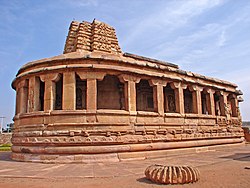The temple has been dated between the late 7th century and the early 8th century of the early Chalukya dynasty. [3] According to Dhaky and Meister – scholars of Indian temple architecture, an inscription discovered in the 1970s confirms that this temple was originally dedicated to Surya, built by someone named Kumara, but does not include a date. On paleographic grounds, the inscription cannot be later than c. 700 CE. [note 1]
Historiography
The Durga temple at Aihole has been a subject of much debate and several wrong theories since it discovery. Gary Tartakov, a scholar of Architecture and Archaeology, has published a lengthy and detailed historiographic review of how it has baffled scholars, been misidentified and how some have wrongly accused early Hindus of appropriating a temple that did not belong to them. [5] [6] [7]
The ruins of Durga temple were re-discovered by Briggs – a British artillery officer in early 1860s. Briggs sensed the significance of its art and structure, took the earliest photographs and published them as "Shivite temple in Iwullee". Shortly thereafter, James Fergusson announced it was "a Buddhist monument" because of its apsidal shape. Fergusson further speculated that it is an example of "inglorious, structural version of a Buddhist caitya hall" that was "appropriated by Brahmanical Hindus". [5] [6] Thus began the long presumed exclusive association of apsidal plan architecture as Buddhist. As other scholars visited and examined other evidence such as the extensive reliefs and panels, the understanding and theories about the Durga temple evolved. James Burgess posited that this must have been a Vishnu temple from the start, as there was no evidence of any Buddhist temple or of appropriation by the Hindus. Henry Cousens was the first to link to it Surya, but through Surya-Narayana (Vishnu). As the Aihole site was further explored, excavated, more thoroughly cleaned up and restored in the 1960s and 1970s, new inscriptions were among the discoveries. In particular, in the cleaned sections of the Durga temple in the 1970s, a new inscription, from c. 700 CE, was found. It was accurately translated by K.V. Ramesh in 1976, later by Srinivas Padigar. This inscription confirmed that the temple was built by Kumara for Hindu deity Aditya (Surya). [5] [6]
According to Tartakov's detailed review of the Durga temple, the inertia of the historic interpretations and the repetition of "stereotyped information" from colonial era scholarship has perpetuated the misunderstandings. According to Sinha – a scholar of Indian architecture and history, instead of the evidence and science on the Durga temple, the original orientalist framework has continued its influence on the Indian authors. Tartakov states that the writing of history of Durga temple as Buddhist or Buddhist-inspired has become a folklore and received truth, no matter what the evidence in the temple and the site says. [5] [7]
According to some scholars such as George Michell, writing before Tartakov's book was published, this 8th-century temple plan derives from rock-cut chaitya hall tradition that existed about a 1000 years earlier in 2nd to 1st-century BCE Buddhist caves. [8] This view has been contested by other scholars who have published their studies after the publication of the Tartakov's book. For example, Himanshu Prabha Ray questions the process of continuity over the ten centuries gap, quotes earliest Sanskrit texts on temple architecture and archaeological discoveries of ancient and medieval apsidal Hindu temples in many states of India. [9]
According to Philip Harding, Durga temple takes the "form of an apsidal temple with inner and outer ambulatories — a form early researchers considered a derivative of Buddhist chaitya halls, but is now generally recognized as a traditional Brahmanical form". [10]













